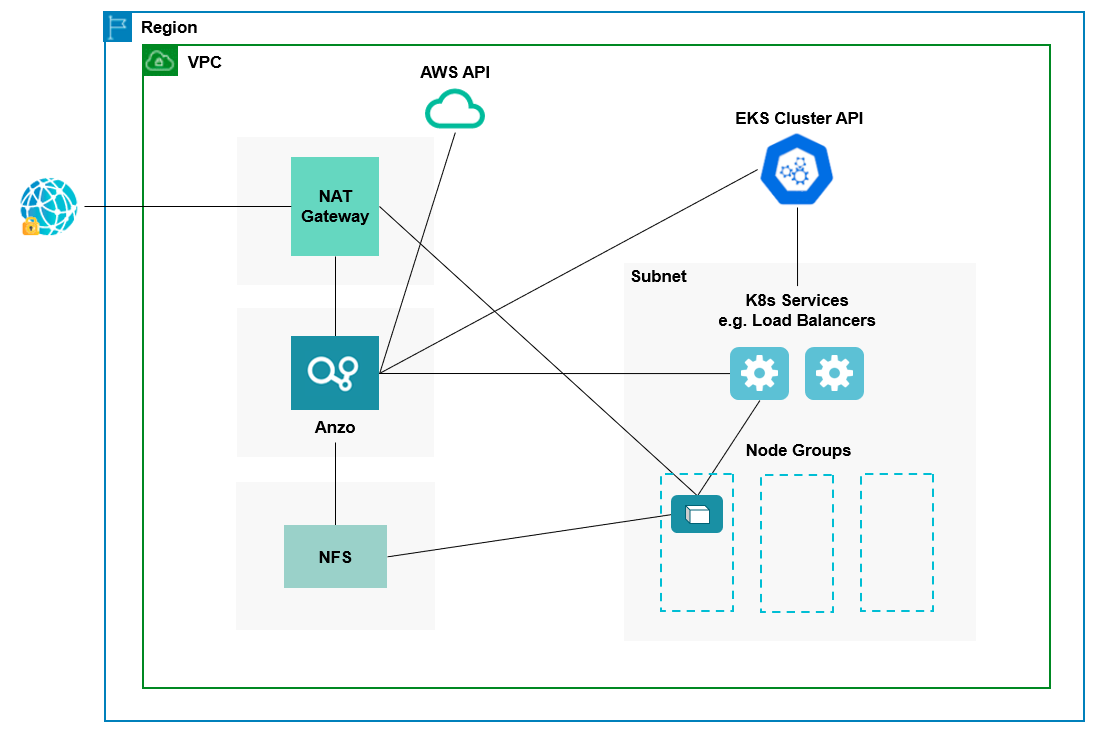Planning the Anzo and EKS Network Architecture
This topic describes the network architecture that supports the Anzo and EKS integration.
When you deploy the K8s infrastructure, Cambridge Semantics strongly recommends that you create the EKS cluster in the same VPC as Anzo. If you create the cluster in a new VPC, you must configure the new VPC to be routable from the Anzo VPC.
The diagram below shows the typical network components that are employed when an EKS cluster is integrated with Anzo. Most of the network resources shown in the diagram are automatically deployed (and the appropriate routing is configured) according to the values that you supply in the cluster and node group .conf files in the eksctl package on the workstation.

In the diagram, there are two components that you deploy before configuring and creating the K8s resources:
- Anzo: Since the Anzo server is typically deployed before the K8s components, you specify the Anzo VPC ID when creating the EKS cluster, ensuring that Anzo and all of the EKS cluster components are in the same network and can talk to each other. Also, make sure that Anzo has access to the AWS and EKS APIs.
- NFS: You are required to create a network file system (NFS). However, Anzo automatically mounts the NFS to the nodes when AnzoGraph, Anzo Unstructured, Spark, and Elasticsearch pods are deployed so that all of the applications can share files. See Deploying the Shared File System for more information. The NFS does not need to have its own subnet but it can.
The rest of the components in the diagram are automatically provisioned, depending on your specifications, when the EKS cluster and node groups are created. The eksctl scripts can be used to create NAT gateways and subnets for outbound internet access, such as for pulling container images from the Cambridge Semantics repository. In addition, the scripts create a subnet for the K8s services and node groups and configure the routing so that Anzo can communicate with the K8s services and the services can talk to the pods that are deployed in the node groups.
When considering the network requirements of your organization and planning how to integrate the new K8s infrastructure in accordance with those requirements, it may help to consider the following types of use cases. Cambridge Semantics supplies sample cluster configuration files in the eksctl/sample_use_cases directory that are tailored for each of these use cases:
- Deploy a private EKS cluster in an existing VPC (i.e., the same VPC as Anzo)
In this use case, the EKS cluster is deployed in a private subnet in your existing VPC. And a new (or existing, if you have one) NAT gateway is used to enable access to external services that are outside of the VPC. The control plane security group is configured to allow access only from certain CIDRs, and communication through VPN can be enabled to allow a virtual private gateway to automatically propagate routes to the route tables.
- Deploy a public EKS cluster in a new VPC
In this use case, a new VPC is created with the specified CIDR. A new NAT gateway is deployed to provide outbound connectivity for the cluster nodes. Public and private subnets are also created, and public access is restricted to specific IP ranges. The new VPC will need to be configured so that it is routable from Anzo.
- Deploy a private, highly available EKS cluster in an existing VPC
In this use case (like the first case listed above) a private EKS cluster is deployed in an existing VPC. In addition, NAT gateways are created in each of the cluster's Availability Zones, making the cluster highly available.
For a summary of the files in the eksctl directory, see Download the Cluster Creation Scripts and Configuration Files. Specifics about the parameters in the sample files are included in Creating the EKS Cluster.
To get started on creating the EKS infrastructure, see Creating and Assigning IAM Policies for instructions on creating the IAM policies that are needed for assigning permissions to create and use the EKS cluster.